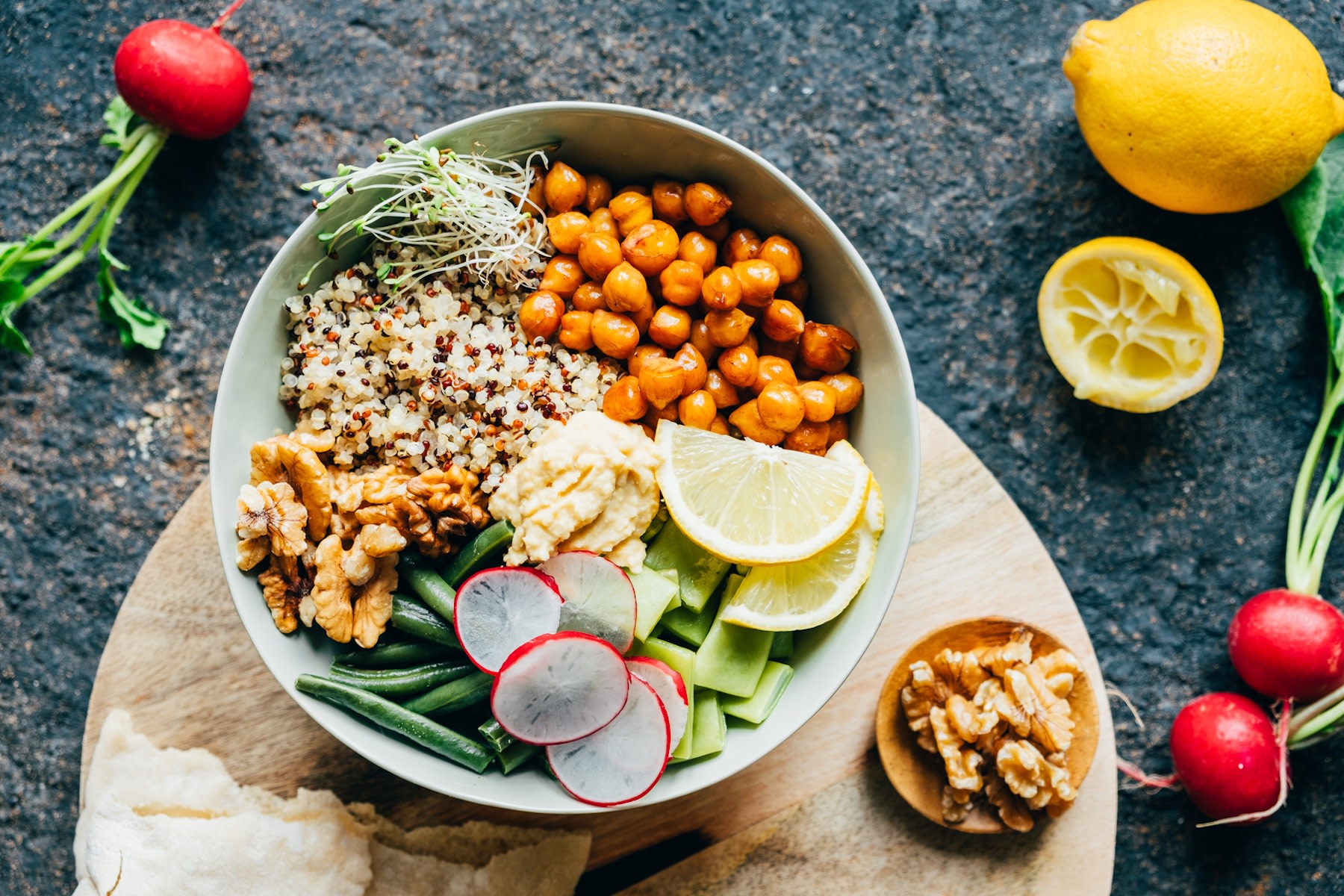
© Nataša Mandić / Stocksy United
The 9 Best Plant-Based Protein Sources, According to Dietitians
It’s time to think outside the egg carton. These plant-based protein sources can help you build muscle and score extra vitamins, minerals, and fiber.
By Karla Walsh•
What Is Plant-Based Protein?
Benefits of Plant-Based Protein
9 Best Plant-Based Protein Sources
Tips for Getting Enough Plant-Based Protein in Your Diet
The Takeaway
When you think of eating protein to gain muscle and energize your day, your brain might jump to popular muscle-building foods like chicken, eggs, salmon, Greek yogurt, or cottage cheese. But there are plenty of strong plant-based protein sources to choose from, too.
Discover more ways to reach your goals with Peloton
Whether you’re vegetarian, vegan, or simply want to eat more foods from plants, opting for plant-based protein can not only support your workout goals (we’re talking to you, strength trainers!), but also deliver additional health benefits. Below, find everything you need to know about plant-based protein, including nine dietitian-loved dietary sources.
What Is Plant-Based Protein?
Alongside carbohydrates and fats, protein is one of the three essential macronutrients our body requires and runs on. Proteins have several important functions, including repairing and building muscle cells, bolstering bones and the immune system, regulating hormones, and aiding in satiety.
Protein can be found in a wide variety of foods and drinks, which can be grouped into two major categories: animal-based proteins and plant-based proteins. The former are exactly as they sound: They’re either made from animals (poultry, fish, seafood, pork, beef, and lamb are common examples) or created by animals (such as dairy products and eggs). Plant-based proteins, on the other hand, are found in dietary sources such as beans and pulses, nuts and seeds, and soy.
Do You Need to Be More Strategic When Eating Plant-Based Protein vs. Animal Protein?
If you’ve heard the chatter about complete vs. incomplete proteins, you might wonder if you need to focus on pairing certain plant-based foods to cover any potential protein or amino acid gaps. But as long as you’re eating a varied diet that includes enough total protein, your body will have everything it needs to thrive.
“For any eater, what matters is eating enough protein,” says Desiree Nielsen, RD, a Vancouver, Canada-based registered dietitian and the author of Plant Magic. This will vary depending on health goals, but a good rule of thumb for the average person is ½ gram of protein per pound of body weight, whether your protein comes from animals or plants or both.”
This goes beyond the minimum dietary requirement (of about ⅓ gram of protein per pound) to better reflect the benefits of eating adequate protein, which is especially important for active individuals and will cover any differences in protein digestibility. If you’re an exclusively plant-based athlete, Nielsen adds that it’s wise to talk to a dietitian, as you might want to increase your protein intake slightly beyond the typical requirement.
Benefits of Plant-Based Protein
There are pros and cons to both plant-based protein sources and animal-based protein sources, according to Nielsen and Kelly Jones, RD, a Newtown, Pennsylvania-based board-certified sports dietitian.
Animal proteins are often (but not always) better sources of absorbable and usable amino acids, as well as iron and vitamin B12, depending on the specific food you’re considering, Nielsen adds. On the drawback side, she explains that animal products often contain saturated fat and no satiating, gut-friendly fiber.
As for plant-based proteins, although they may sometimes have more limited amino acid content and are usually lower in iron and vitamin B12, there are tons of benefits to adding more plant-based protein sources to your diet, the dietitians we spoke to agree. Plant-based proteins are:
Rich in antioxidants. The antioxidant content of plant-based proteins trumps that of animal proteins, Jones says. “Plant-based protein sources provide a variety of phytochemicals that support short- and long-term health and play a role in chronic disease prevention,” she explains.
Good for the gut. “An emphasis on plant proteins for omnivores helps to increase dietary fiber, which most Americans are lacking in, as well as other non-digestible carbohydrates that support the gut microbiome and its role in overall health,” Jones says. When choosing whole plant foods for protein (rather than, say, supplements), this fiber also supports satiety, which is helpful for those concerned that plant-only meals may not be as filling as those with animal foods.
Tied to a lower risk of several chronic diseases. The research is quite clear, Nielsen says: A more plant-based dietary pattern is associated with a lower risk of chronic disease such as heart disease and some cancers, as well as a lower risk of early death. “You don’t need to be vegan to eat more plant-based meals,” Nielsen says. “Whether you extend your meals with plant protein, or introduce two to three plant-based meals a week, eating more plants is a win-win.”
Usually more budget-friendly. Dried beans in particular earn Nielsen’s stamp of approval for being a more affordable plant-based protein source, which can help you save a bit on your food budget. “My grandparents often ‘extended’ meat with legumes, which is a great way to increase affordability, fiber, and lower saturated fat,” she adds.

© Nataša Mandić / Stocksy United
9 Best Plant-Based Protein Sources
If you’re feeling inspired to pump up your protein intake with more plants, here are some of the best options, according to Nielsen and Jones. (We’ve listed them in order of most to least protein based on typical serving sizes and nutrition estimates from the US Department of Agriculture’s FoodData Central nutrition database.)
1. Tempeh
Protein per 1 cup: 34 grams
Tempeh is a block of fermented whole soybeans, which can be broken down into meat-like crumbles. You can think of it as tofu’s big sister, as tempeh offers more protein than its fellow soy protein option.
Jones enjoys it cooked, sliced, and stacked inside wraps and sandwiches or on top of salads, while Nielsen suggests using crumbled tempeh in curries, stews, and tacos.
2. Tofu
Protein per 1 cup: 20 grams
Available in silken, soft, firm, and extra-firm varieties, tofu is made by transforming soy milk into curds, then pressing those curds into a block.
Tofu is low in FODMAPs, which are fermentable oligosaccharides, disaccharides, monosaccharides, and polyols that the small intestine has trouble digesting. “That means it’s a great first plant protein for those who have digestive issues like irritable bowel syndrome (IBS), as it won’t cause a lot of extra gas or bloating,” Nielsen says.
Flavor-wise, tofu is a blank slate for whatever you season it with or blend it into. Try the firmer kinds marinated and roasted, sauteed, grilled, or air-fried to act as an animal protein alternative, or blend softer tofus into a smoothie or ricotta substitute.
3. Edamame
Protein per 1 cup serving, cooked: 18 grams
Soy proteins of all kinds, including tempeh, tofu, and their cousin edamame, rank near the top of Jones’ plant-based protein source list for active individuals. That’s because they deliver all nine essential amino acids you need by themselves, making them a great source of protein for plant-based eaters.
Frozen shelled edamame is particularly convenient to toss into stir-fries, salads, or grain bowls. You can also seek out bags of roasted edamame, which are ideal for on-the-go snacking.
4. Lentils
Protein per 1 cup cooked: 18 grams
Remember what we said about plant-based protein sources and iron? Just 1 cup of cooked lentils delivers about one-third of the iron an adult woman needs each day and three-quarters of what an adult man should strive for.
“For those following vegan or vegetarian diets, plant proteins such as soy, beans, lentils, and whole grains are great ways to obtain more iron, the nutrient with the highest rates of deficiency in the US, and one that athletes and vegans have higher needs for,” Jones says.
You can also consider lentils one of the best all-natural fiber “supplements,” since a cooked cup adds a whopping 16 grams of fiber to your daily quota.
Dried lentils are versatile, affordable, and cook fairly quickly. Add them to soups, stews, and pasta sauces; seek out lentil-based pasta options at the grocery store; or whip up a batch of lentil tacos or sloppy joes.
5. Chickpeas
Protein per 1 cup cooked: 15 grams
While all legumes are solid sources of plant-based protein, chickpeas (aka garbanzo beans) get a gold star from Nielsen for their versatility and the nearly 13 grams of filling fiber that just one cup delivers.
Hummus is a popular vehicle for chickpeas; try it scooped up with lentil chips for a double dip of plant-based protein foods. Roasted chickpeas also make for a quick and easy snack, offering a terrific swap for fans of chips. You can also add chickpeas to soups, stews, and pasta dishes, or consider replacing canned tuna with smashed chickpeas in your next creamy salad sandwich.
6. Hemp Hearts
Protein per 3 tablespoons: 10 grams
Many seeds, such as chia, flax, and pumpkin seeds, are fiber and protein powerhouses. However, nutty-flavored hemp hearts, which are the soft inner parts of hemp seeds, stand out for their impressive protein and omega-3 fat content. Hemp hearts are nutrient-dense—they offer some iron, potassium, and fiber as well—and they’re a breeze to add into your diet, Nielsen says. (A little bit goes a long way to inching you closer to your protein goals!)
Stir hemp hearts into oatmeal or yogurt, add them into smoothies, or sprinkle them over soups, stews, or salads.
7. Soy Milk
Protein per 1 cup: 8 grams
The plant-based milk section of the grocery store seems to expand every month. It can be daunting trying to find the “best” option for you, and nut, oat, and other plant-based milks all have a place, Jones believes. But if she was forced to choose just one as a top suggestion for those who don’t consume dairy, soy milk beats the competition thanks to its protein content, which is comparable to cow’s milk.
Sip on a big glass of soy milk by itself or use it in a smoothie for a post-workout refuel. You can also use it in baking recipes or sauces, or pour some over cereal or granola.
8. Quinoa
Protein per 1 cup cooked: 8 grams
The entire category of whole grains is home to several great plant-based protein foods—for instance, farro, bulgur, and wheat berries are all stand-outs in the protein department. However, quinoa earns a spot on our best plant-based protein sources list for its ease of use and availability in both dried and pre-cooked, heat-and-eat form. Not to mention, 1 cup of cooked quinoa comes with 5 grams of fiber.
Prepare a big batch of quinoa ahead of time to mix and match with beans, legumes, lentils, vegetables, and a sauce or dressing for quick and easy lunches.
9. Pistachios
Protein per ¼ cup: 6 grams
Plenty of nuts are packed with worthy plant-based protein, including peanuts, cashews, and almonds. But pistachios appear to have the highest protein digestibility corrected amino acid score (PDCAAS) among nuts that have currently been scientifically tested. That means that the protein in pistachios is fairly easy for the body to access and utilize to repair and build muscle, plus perform other important body functions.
Try pistachios as a snack by the handful, in place of croutons on salads, sprinkled over roasted vegetables, or ground into a coarse powder and used as a breadcrumb swap.
Tips for Getting Enough Plant-Based Protein in Your Diet
Regardless of whether you’re fully vegan or simply dipping your toe into the flexitarian space, there are many savvy (and simple) ways to sneak in more plant-based protein sources into your diet. Beyond the recipe ideas mentioned above, Nielsen and Jones recommend:
Adding hemp hearts or any small seeds to batter used for quick breads, muffins, pancakes, or waffles
Investing in smoked tofu for easy meals or snacks—no cooking required
Stirring mashed beans into pasta sauces, soups, and stews to lend a rich texture
Blending a couple tablespoons of nut butter into a smoothie or bowl of oatmeal
Sprinkling nutritional yeast (8 grams of protein per 2 tablespoons!) onto popcorn for vegan “cheesy” flavor
Jones and Nielsen note that whole-food plant-based protein sources should ideally make up the majority of plant proteins in a nutritious diet. That being said, don’t be shy about turning to plant-based meat alternatives every so often. Just be sure to peek at the nutrition information and, when possible; Jones suggests seeking out items low in saturated fat and made with bean or legume proteins and mono-unsaturated rich oils.
The Takeaway
Plant-based protein sources are often misunderstood and deemed as “lesser” than animal proteins, but both options have their pros and cons. If you choose wisely, many plant-based protein foods provide a wide array of benefits, such as healthy doses of fiber, antioxidants, vitamins, and minerals. Plus, research hints that opting for a more plant-forward diet may lower your risk for several chronic diseases that are among the leading causes of death in America.
The best plant-based protein sources include soy products, whole grains, nuts, beans, legumes, pulses, and seeds. Don’t be afraid to turn to plant-based meat substitutes as you transition into eating more non-meat meals; just try to prioritize foods that are low in saturated fat and composed of some real plants, like beans or legumes.

Peloton App
Access thousands of classes with no equipment needed.
This content is for informational and educational purposes only and does not constitute individualized advice. It is not intended to replace professional medical evaluation, diagnosis, or treatment. Seek the advice of your physician for questions you may have regarding your health or a medical condition. If you are having a medical emergency, call your physician or 911 immediately.
This content is for informational and educational purposes only and does not constitute individualized advice. It is not intended to replace professional medical evaluation, diagnosis, or treatment. Seek the advice of your physician for questions you may have regarding your health or a medical condition. If you are having a medical emergency, call your physician or 911 immediately.
Get our latest health stories straight to your inbox
Enter your email to get articles, expert-backed tips, and updates from Peloton sent to your inbox.
By providing your email address, you agree to receive marketing communications from Peloton.
For more about how we use your information, see our Privacy Policy.








